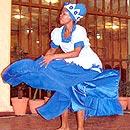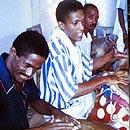Regla Osha
Yoruba civilization is considered one of the richest puzzle pieces of the Caribbean culture. This religious code reached the shores of the New World in the collective memory of African slaves who later relayed them orally to their offspring.
Today, its philosophical assets make up part of the spiritual heritage of West Indians, regardless of the many transformations they went through following a clash with other African and European religious forms. The combination of all these religions gave way to syncretism with its array of cosmological assessments in tow that eventually matched Yoruba deities with Catholic saints.
As Negroes made a simple juxtaposition of ideas taken from the teachings of Catholicism and fetish beliefs brought from Africa, local dwellers (known as Creoles) tend irreversibly to the combination of creeds and the identification of those teachings depending on the demands of their particular context.
Yoruba people believe the universe is a sphere split in two parts. The upper echelon is dominated by Orun (heaven), the kingdom of the Supreme Being, the gods and the souls of the ancestors that only there reach the condition of natural forces. The upper part harbors Aiyé (the physical world) inhabited by human beings for a certain span of time in order to fulfill the mission they have been committed to and only then make their way up to Orun.
The Yoruba religious system (Regla Osha) is nothing but a combination of beliefs and rites based on adoration to the Orishas enshrined in the Nigerian pantheon. This practice stems from a conceptual principle built on the Orishas that clearly defines the paradigm of all universal elements. We can talk about a trilogy whose elements have functions of their own:
• Olofi, the Supreme God, has a say over the rest of the Orishas but is not worshipped in any form. He built everything there is on earth. That's why he's said to cherish the secret of creation. He doled out powers among all of the Orishas and made them his messengers on the face of the earth.
• Oloddumare is the representation of the natural laws, both the material and spiritual manifestation of everything on earth. Nobody can offer him or ask him for anything. Practitioners talk to him through Olofi.
• Olorun is the sun, the most realistic manifestation of Olofi and Oloddumare. He's the sign of life and creation, the underpinnings of human existence.
The religious code of the Orishas is closely linked to the notion of family. A religious brotherhood is established between godfathers and their godsons and goddaughters –despite their not being direct offspring or siblings- as it originally came to pass in Africa. The Caribbean context demanded the shift from natural families to ritual families as slavery weeded out blood-linked lineage.
Thus, each religious family has a functional ethnic origin that has spread in an process of nonstop initiations in which the predecessors' cultural principles are preserved.
For its part, this cult is observed in house-temples, that is, in the homes of religious leaders where representations, elements and artifacts to be worshipped are neatly kept.
For practitioners of this kind of religion, the heart of the matter lies in a respectful cult of the Orishas through adoration, feeding and compliance with all religious dates and rituals within the liturgy. Each house-temple, every officiator and santero worships the Orishas and passes on the traditions to their offspring as they received them from their ancestors.
Perhaps that explains the existence of some differences, even though the very essence of the cult has remained unaltered for centuries. Something that must be kept in mind is the fact that person-to-person exchanges trigger transformations within a specific moment in time and social environment.
Like any other religious manifestation, Regla Osha is also divided in echelons: the upper hierarchy is represented by the babalawo who is blessed with the attributes Orula gifted him with. Orula is the god of divination and uses the board of Ifa and chains, also known as opele or ekuele. Only men are entitled to such an upper echelon.
Another major notch within this hierarchy is the babalocha or iyalocha, that is, the santero or santera that takes a specific part of the liturgy such as divination through the diloggun or obi.
However, the oriates or wise men are involved in the reading of the Diloggun (16 snail shells) in charge of guessing the Ita or fate a certain worshipper will be subjected to during his stay in this material world. They usually emcee most anointments and ceremonies. Another relevant figure is the oyubbona or yimbona , the one that accompanies and guides the initiated person through all the actions he or she is supposed to take for seven days straight to become a “saint.”
The aforesaid African oracles have exerted a huge influence on the religious life of Yoruba-origin Caribbean communities. This credo has caught on and marked the behavior of worshippers.
Consultations are commonplace and embrace responses to all problems, from the most difficult ones to the very simplest. A case in point is the yearend ceremony with a tour around the houses of Ifa in an effort to foretell future events. In this process –comprising the year's last three days- worshippers make heftier offers and rituals to hail the Orishas as they predict social, natural and political developments to come.
These three systems –the Ifa divination, the Diloggun and the Obi- have helped to perpetuate cultural traditions and the tongue of African ancestors, two elements ingrained in the deepest Caribbean roots.
A number of religious ceremonies take place within the cult of the Orishas. Some of them are devoted to one specific god with a view to express gratefulness or happiness for a certain gift bestowed on worshippers.
Initiation ceremonies are weeklong events. Persons to be initiated must undergo a different ritual each day to be ready for his or her life as a practitioner. One particular day is the drum day. The initiated person anoints himself or herself to the holy drum (bata) and dances in front of it in meaningful recognition to its position within the liturgy.
In the same breath, the mourning ceremony of itutu, as well as the bembes or vemileres, are celebrations that draw in scores of people in a sprightly spirit. With these observances, the faithful strengthen their relationship with their own guiding or protecting deity as they attempt to harmonize the forces of good and evil in pursue of spiritual and material needs alike.
The spirit-fetish-magic relation takes center stage in the Yoruba religious code due to its utilitarian and propitiatory character. Otanes (stones) are the objects that symbolize the supernatural powers of the those Orishas people are paying tribute to.
The spirits or souls of the ancestors, nature, the sun and the moon are some elements that cannot be ruled out when it comes to observing these rituals. These rites are usually marked by an esoteric and magical language that allows the establishment of communication channels between deities and believers.
In Africa, more than 405 deities have been registered and people worship each and every one of them in different regions within the continent. In the Caribbean, those deities came together into one single ritual and only the most functional divinities in the new environment elbowed their way through worshippers within the regional communities.
The number varies depending on the context in which a particular religion is being observed, but they hardly ever exceed thirty deities: Eleggua, Obbatala, Yemaya, Ochun, Oggun, Chango, Ochosi, Babalu-Aye, Oya and Orula are some of the commonest Orishas. They all sailed through the seas of memory only to anchor forever in Caribbean lands.
These gods comprise an ambivalent character, have a sense of justice and try to strike a balance between right and wrong. Revolving around each and every one of them, there are countless legends or patakies that have kept alive the dearest traditions of the Yoruba world.
On the other hand, the representation of symbolic elements is not unvarying everywhere. The process lays bare both the loss and assimilation of cultural patterns that chip away at a certain culture when it clashes with a similar one.
Today, Regla Osha is observed in Cuba, the Dominican Republic, Venezuela and Puerto Rico. It's worth mentioning, though, that some elements of its cosmology have pried into other African-Caribbean religious manifestations. Their significance in time stems from the addition of their own symbols, myths and cults to the idiosyncrasy and culture of those people that observe these religious systems.
As Negroes made a simple juxtaposition of ideas taken from the teachings of Catholicism and fetish beliefs brought from Africa, local dwellers tend irreversibly to the combination of creeds and identify those teachings depending on the demands of their particular context.
For practitioners of this kind of religion, the heart of the matter lies in a respectful cult of the Orishas through adoration, feeding and compliance with all religious dates and rituals within the liturgy. Each house-temple and every santero passes on the traditions to their offspring as they received them from their ancestors.
The observance of Regla Osha in the Caribbean lays bare both the loss and assimilation of cultural patterns, a commonplace process that takes place when two cultures clash with each other.






































































